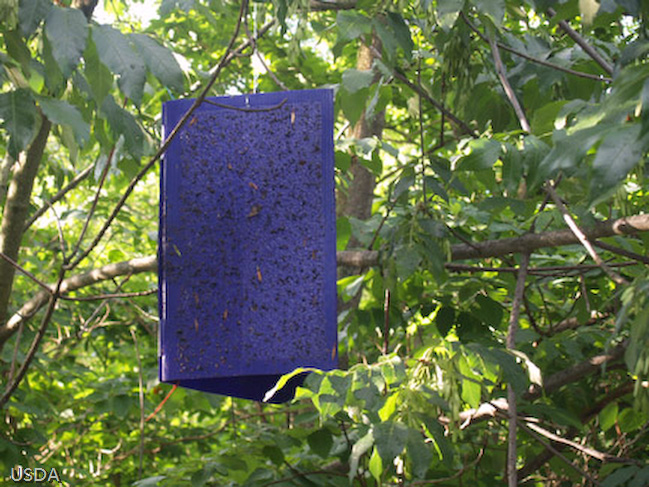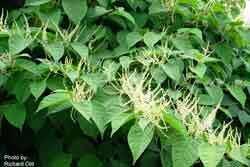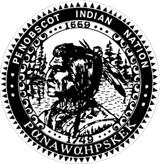Invasive Species of Concern
BUGS IN THE FOREST
Emerald Ash Borer (EAB)

Adult insectsEmerald Ash Borer (EAB) is an invasive insect that can kill an ash tree within 2-3 weeks. It is most often moved around by people transporting firewood, which is why it is very important to buy firewood near the place where you are camping or recreating. Currently, the nearest known outbreak is in Concord, New Hampshire. The EAB attacks any species of ash, including brown ash, which is a culturally significant tree species to tribes in the Northeast.
Purple prism trap to monitor for EABCurrently, members of the Penobscot Nation DNR staff are working with the USDA-APHIS Program to monitor for the presence of EAB throughout the State of Maine and develop a plan of action to be implemented once EAB arrives in our region.
Click here for more information on Emerald Ash Borer.
https://youtube.com/watch?v=-hUQyzXIp0I%3Frel%3D0%26wmode%3Dopaque

Hemlock Wooly Adelgid (HWA)
Hemlock Wooly Adelgid infestationHemlock Wooly Adelgid (HWA) is another invasive insect of significant importance to the Penobscots’. Individually, adelgids are very tiny but clump together and look like small cotton balls. They are found on the underside of hemlock needles and effect only hemlocks. Identification is easiest during November – July.

HWA is currently found in southern and coastal Maine. The Atlantic Ocean is said to be a great transportation route since birds can transport HWA. Another way HWA is transported is through hemlock trees that people buy at greenhouses or plant nurseries. One plant in the nursery can infect others and when the tree is brought to the homeowner’s property it can spread to hemlocks there as well.
Click here for more information on Hemlock Wooly Adelgid.
PLANTS ON THE LAND/NEAR WATER
Purple Loosestrife

Fireweed (left) is often mistaken for purple loosestrife (right).Purple loosestrife is an invasive plant with a distinct square woody stem and purple flower. It is rarely found on trust lands, but is established on Indian Island along the boardwalk, pond and various drainage ditches.
This plant has the potential to out-compete native vegetation in wetlands and significantly limit diversity of plants and wildlife. Large populations of loosestrife are extremely difficult (if not impossible) to control for Natural Area Managers. Hand pulling or digging up plants is only successful when the small plants are newly established. It must be done thoroughly and at the right time of year so seeds are not being spread during the pulling. This method has worked well on the PIN trust lands. Please contact the DNR forestry program for input on how to remove purple loosestrife.
Click here for more information on Purple Loosestrife.

Japanese Knotweed

.Japanese Knotweed is an invasive plant found in moist areas that can grow up to 9 feet tall and has the potential to out-compete native vegetation. Currently, it is present in most Maine counties and on Indian Island. There are no known occurrences on other tribal lands at this time. People often refer to Japanese Knotweed as “bamboo.” Cutting it down is extremely ineffective as often 2 new sprouts will grow from the one stem that was cut down.
Click here for more information on Japanese Knotweed.
PLANTS IN THE WATER
Invasive plants are plants that are not native to an area but when introduced invade and take over. These exotic plants can grow on land as well as in the water, and outcompete the native plants and harm the ecosystem. Once they are introduced to an area they are extremely difficult to control, and the longer they have been in a place it is almost impossible to get rid f them. While this page only cover the invasives that live in water, REMEMBER all invasives are a threat to our beautiful lands, rivers, lakes, and streams.
WHY SHOULD YOU CARE?
Here are some of the reasons why these foreign plants are bad:
- They grow fast
- They take over native plants
- They are hard on fish (at night they use up lots of oxygen)
- They make it harder to swim, fish, and boat.
WHAT CAN YOU DO?
- When you’re out there, take a look around! Notice the common ones (which are most likely native) you see! That way when you do see something very different (the invasive) it will be obvious to you. Try to see as much of the bottom as possible – maybe even use something to help, like a viewing tube. If you do see something very different, try to mark the spot on a map, by an anchored buoy, and take notes of landmarks (shoreline cottages, unusual rocks or trees, etc.) to help others re-locate the site. If you have a GPS, take coordinates. You could also take pictures of the area. Please contact Water Resources Program IMMEDIATELY so that we can investigate further.
- After every trip, be sure to clean all equipment of any plant debris and dispose of it in the trash. These foreigner plants can survive for a very long time on shore with no water, and it is illegal to have them hanging off your boat trailer or other equipment.
- Avoid disturbing plants unless a sample is required. Many water plants (native and invasive) can spread by broken off pieces of any part of the plant. Samples should only be obtained if you have the right equipment and then by a clean cut, if possible. Scoop up any and all pieces with the leaf rake or a net.
WHEN SHOULD YOU DO IT?
July through September is generally the best time of year to start paying attention to the bottom and to look for plants. Before July, many water plants are not fully developed. The flowers that grow above the water are sometimes needed for identification and for many plants flowers do not typically start to develop until July. Curly-leaf pondweed is an exception to this rule, usually reaching maturity by late spring to early summer.
WHY DO WE NEED HELP LOOKING FOR THEM?
WRP does not have enough staff and time to patrol all our waters for these invasives. But with your help, together we can protect our native plants and animals and prevent these plants taking over. We need help from everyone who enjoys our rivers, streams, lakes, and ponds by keeping an eye out for the eleven most wanted invasives, five of which are already in Maine.
Early detection is the best hope of wiping out these pesty little buggers and preventing them from getting established. While getting rid of these plants completely may not be possible, early detection can help manage them effectively using low-impact methods.
WHAT ARE OTHER PEOPLE DOING ABOUT THIS?
The Maine Volunteer Lake Monitoring Program is a widespread citizen group that helps protect Maine lakes through the gathering and sharing of valid scientific information pertaining to lake health. The VLMP trains, certifies and provides technical support to hundreds of volunteers who monitor a wide range of indicators of water quality, assess watershed health and function, and screen lakes for invasive aquatic plants and animals. Since the first Invasive Plant Patrol (IPP) workshop in 2002, the VLMP has trained thousands of individuals to screen Maine waters for invaders. The program was specifically designed to engage widespread participation by individuals with varying amounts of time and expertise to commit to the endeavor, from those who simply want to be more knowledgeable when they are out recreating on their lake, to those who are conducting and leading comprehensive lake-wide searches. The funding the for this program comes from a portion of the state’s boat registration fees and donations. The trainings are free, and some of the PIN WRP staff have taken these trainings to increase our knowledge. Here is a link that has all the listing for workshops on plant identification (http://www.mainevlmp.org/invasive-plant-patrol-workshops/).
According to the Maine Volunteer Lake Monitoring Program (MVLMP), “As of March 2013, twenty-four Maine waterways (encompassing forty-six distinct waterbodies) are known to be infested with invasive aquatic plants. Variable water-milfoil is still the most widespread of the known invasive aquatic plants in Maine. Other invasive aquatic plants present in Maine include curly-leaf pondweed, Eurasian water-milfoil, European naiad and hydrilla.”
The MVLMP website (http://www.mainevlmp.org/) has a variety of very helpful resources including workshops to train you how to identify invasive plants, and how to conduct courtesy boat inspections, a map of all the lakes they have been to, and other tools to use to help protect lakes.
If you have any questions or comments feel free to contact DNR anytime! Woliwoni
